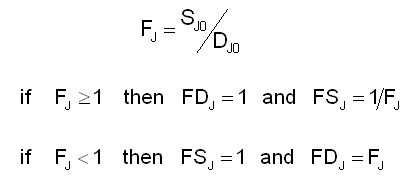Our discussion of commodity markets centered on the level OJK of a commodity J that has been produced in economy K, but remains un-purchased. This quantity is modeled as wasting its economic potential at a rate VJ•OJK, where VJ is J’s turnover fraction. Model 0's notion of supply SJK is defined by adding this ‘market pressure’ to the rate YJK at which J is currently produced in K:

Our discussion of how adjustments to physical asset levels can be controlled identified an individual sector IK’s demand for commodity J QIJK as:

Model 0's notion of domestic demand DJK sums demands of the sectors I for J in K:

Simple addition across all M of the economies K provides global (K = 0) totals YJ0, OJ0, SJ0, and DJ0 for all the variables subscripted JK in these equations. Where SJ0 and DJ0 are equal for given commodity J, we can be assured that there exists an export/import profile XJK such that XJ0 is null, and that all domestic demands DJK are satisfied by the sum of domestic supply SJK minus exports XJK:

(Per the SFEcon sign convention, a negative value for XJK indicates a quantity that is imported.)
Working as we are within the neoclassical paradigm, we can anticipate creating a regime of prices that tends to equate demand with supply; but this tendency is necessarily imperfect for any dynamic model — as, indeed, it must be for any objective counterpart of what the model portrays. It is therefore essential to exhibit at least one mechanism whereby the XJK’s are calculated such that XJ0 will a) approximate zero to the extent that the integer zero can be expressed as a real number by a digital computer, and b) vary from zero in a way that is temporally unbiased to the positive or negative.
This is most easily done by envisioning a quantity DJ’ for the amount of global demand DJ0 that will be satisfied at any given point in time, and a quantity SJ’ for the amount of global supply SJ0 that will be used at any given point in time. At any moment, one of two things must be happening: SJ0 will be diminished to SJ’; or DJ0 will be diminished to DJ’. The factors accomplishing these diminutions are named FSJ and FDJ; and, at any given moment, one of these factors must unity, while the other must be less than unity.
The factors FSJ and FDJ both derive from the ratio FJ of global supply SJ0 to global demand DJ0:

FSJ and FDJ will then determine exports/imports XJK of commodity J from/to economy K:

This equation assures the export/import profiles are such that any XJ0 will always compute as close to integer zero as is possible for digital representations of real numbers; and the overall global system never attempts to export more than is imported, or to import more than is exported, irrespective of imbalances between supply and demand.
FDJ also serves to prevent the sectors IK from taking J off the market in excess of what is being supplied:

Here we arrive at the final definition of the asset replenishment rate RIJK that controls SFEcon’s circuit of physical flows. Whenever the global supply of J equals or exceeds global demand and FDJ is unity, the rate RIJK at which a sector IK takes a commodity J off the market equates to the optimal rate QIJK for IK to use J. When supplies of J are not adequate to meet demand, FDJ less-than-unity serves to ration asset replenishment rates. An overabundance of supply for J will be absorbed into the market, where (as we shall see) it depresses prices.
Small negative quanta appearing here and there on the market are allowed as indicia to the model that a given commodity J must be rationed. ‘Conservation of mass’ is required insofar as a market is only allowed to go negative to the extent possible during one differential element of time, given that the market variable began that differential element of time as a positive quantity. Conservation of mass is reinstated by the definition of supply SJK as output YJK plus market pressure VJ•OJK: where market pressure is a tad negative, supply becomes a tad less than current output; and demands are never allowed to be satisfied in excess of available supply.